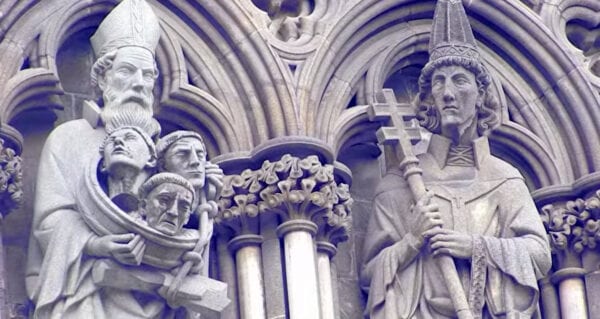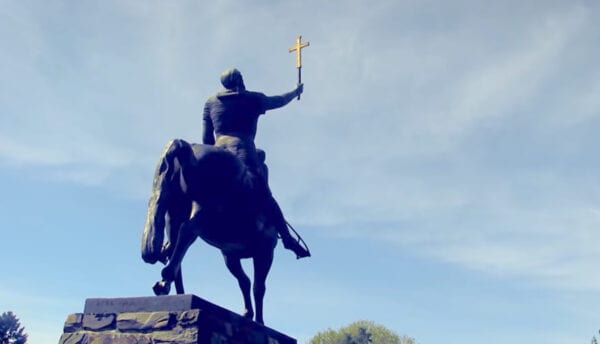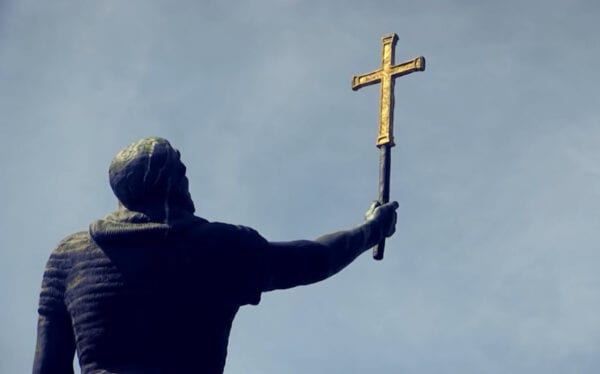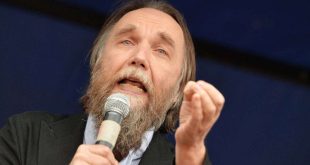Herland Report: In our series about the Viking Age, this article focuses on the Eternal King of Norway, as Saint Olaf Haraldsson (995 – 1030 AD) is known as.
He is not only the Patron Saint of Norway, but one of the most important and legendary characters in Viking history.
At the festival of Olsok, we remember his life and death at Stiklestad in 1030.
His reign was filled with fierce battles and reforms, solidifying the constitutional fabric of the country and tying the country together to form a national union.
Olaf Haraldsson held the characteristics that Norwegians at the time admired, making him a hero in the memory of the people, as told by Snorri Sturluson, Flateyjarbok and other Scandinavian chronicles. (Feature photo: Herland Report. Olaf Haraldsson statue at the Saint Olaf church in York, erected 1050 AD, twenty years after Olaf’s death.)
What made Olaf a Saint, according to Catholic and Christian Orthodox tradition, was his struggle to surrender fully to God, and his final success in doing so. All his life he had been among Vikings, so the Viking-mentality was all he knew.
He performed the voluntary ride into death – the essence of martyrdom. His death at Stiklestad finally fulfilled his search for God: by submitting to God’s Will he finally overcame his own dragon.
This was the man who completed the Christianization of Norway that changed Norway forever. Through his dramatic life as a fierce warrior, and ultimate sacrifice, he became the national symbol of patriotism.
The Herland Report celebrates 10 million views on YouTube in just a short while and release interviews and a series of articles about the spectacular Viking Age.

The Early Life of the Warrior Saint
Olaf Haraldsson’s stepfather was Sigurd Syr, the petty king of Ringerike and great-grandson of King Harald Fairhair. His mother’s name was Aasta (Åsta), she was also the mother of Harald Hardrada (Hardråde).
Sigurd was known to be a wise and prudent man and exerted significant influence in Eastern Norway. He had converted to Christianity in 998 AD under Olaf Trygvasson’s reign.
At age twelve, Olaf was sent on a Viking expedition under the care of the Viking warrior Rane. The expedition took the young boy across the Baltic Sea, exposing him to harsh raids at a very tender age. He would not return to Norway until 1014.
Olaf Haraldsson’s first deployment was in Northern France, where he was lent out to the Duke Richard II of Normandy. Olaf and the Duke visited the Cathedral in Rouen in France together, where they discussed Christian theology with the Archbishop.
In 1013, Olaf Haraldsson was christened in Rouen in Normandy and baptized there in 1014 by Robert, the Archbishop of Rouen, according to Norman history. Rollo or Gangerolf from Giske in Viking Norway was also baptized in the same cathedral in 915 AD.
It was the “song of Rollo” that the Norman warriors later sang when commencing the Battle of Hastings against King Harold Godwinsson in 1066. This battle was to be won by William the Conqueror, decendant of Gangerolf /Rollo and Norwegian Vikings.
This also speaks for the closeness of the Norman rulers to their Viking kinsmen from Norway and Scandinavia. It adds to the likeliness of a coordinated attack between Hardrada and William the Conqueror on England in 1066 AD.
The quest for the Viking throne of Norway
In the same year of the Anglo Saxon King Cnut’s invasion of England, Olaf Haraldsson had set out to return to Norway. He had about 300 warriors with him, a handful of priests and friends. Battles and cunning diplomatic missions followed, resulting in Olaf becoming the King of Norway.
Olaf Haraldsson’s reign was deeply influenced by Charlemagne and the feudal Kingdoms of Europe. Olaf sought to implement the European model to Norway, meaning centralizing power to himself as King.
This is an article in a series as we address the Viking Age:
- Harald Hardrada: Viking Warrior king of Norway, friend of Russia, commander in Constantinople.
- Snorri Sturluson and the warriors of Scandinavia.
- The Viking cradle of Odin, Norse history and migrations in Scandinavia.
- The VIKING raids, expansion and the creation of Russia.
Of course, this was very controversial as it trespassed the conventional boundaries of a Norse monarch. Norway was traditionally governed by localities: thing assemblies, independent farmers, and petty kings. Olaf’s road to centralization was riddled with opposition.
He also sought to complete the Christianization of his predecessor. While the rest of the country had more or less remained Christianized, the Uplands and Trondelag had relapsed into Norse paganism. The Uplands were in rebellion.
Olaf ordered his agents to capture the rebel leaders while asleep, torture them and release them back into society as a chilling warning. The King struck with an iron fist.
In 1020, he headed to the Far North, to establish power there. For the first time, virtually all of the Norwegian lands were under the authority of a single King [1] – Olaf Harldsson held more power than any other Norwegian King before him.
Trondelag, as usual, was hard to subjugate. The Norse norrøn blot rites continued and the Tronds kept Olaf at bay through deception and diplomacy. One day, Olaf had enough.

He arrested their leader Olve, confiscated their lands and wealth, exiled numerous persons and forcefully implemented his own network of governors.
The most notable of these new governors was Earl Kalf Arnesson, one of Olaf’s companions, who was entrusted the governorship of all Trondelag. Similar reprisals were taken against other rebellious kings in Hedemark and Gudbrandsdalen.
What happened in Trondelag is a classic example of how King Olaf centralized the country. He pushed his own direct authority nationwide, sacking those who protested.
The only person he truly struggled to fully humble was Erling Skjalgsson, who continuously tried to re-instate his former powers. Olaf and Erling frequently feuded, as both stubbornly refused to back down. It was just a matter of time before they would clash violently.
Theoretically, the Christianization of Norway was complete at this point. However, folks knew little about the actual Christian faith. In some cases, they worshipped Kvite-Krist (the Norse name for Jesus Christ, directly translated White-Christ) alongside their Norse gods.
It was therefore necessary to establish a national church institution that could hold mass every Sunday and preach the pillars of Christianity. As a monarch, Olaf additionally wanted to construct a new, national legal code, based on Christian virtues.

The Moster Assembly implements Christian Laws 1022
Around 1022/23, Olaf held a large thing assembly at the island of Moster – a symbolic place as it was here Olaf Tryggvason founded his first church.
Attending the thing were priests, theologians, state servants and Bishop Grimkell, Olaf’s religious mentor. They dictated a new law code they named “Kristenretten” (the Christian Law).
It prohibited polygamy, adultery, wizardry, abortion [2], blood-vengeance, pagan rituals and specified what was required of every Christian.
It also established the rules and procedures of the Church. In accordance with this, Olaf systematised the building of churches by laying out how they should be spread across Norway to preach Christianity.
The thing assembly at Moster unified Church and State, thus formally founding the Church of Norway and officially making Norway a Christian Kingdom.
Along with the Christian Law came a formal implementation of feudalism – an enhancement of Olaf’s grip on power at the expense of Earls, chiefs and petty kings. In accordance with this, Olaf confiscated large farms and properties and allocated their ownership to the State or the Church.
Old chieftains and local rulers were replaced with lendmenn – local governors appointed by the King – and promoted årmenn – state servants who monitored and scrutinised the governors.
This shook the entire country, as it rattled the heart of Norse customs and traditions. The most controversial was his property confiscations. It gave him many bitter enemies.
However, many argue that such controversial actions were necessary to modernize the Kingdom. If the King’s and Church’s position were to be elevated, they needed land. Land ownership was the currency of the day. Also, though it outraged the Norwegians, it was nothing but the standard, feudal social structure of medieval Europe.
Olaf Haraldsson emulated the European monarchs, making Norway a Kingdom of an absolute monarch, supported by a clergy and an aristocracy. This may have made sense to other international Norwegians – but for the average farmer, it was an outrage. This modern Europeanism certainly was not so charming to them.

Wars with Denmark and King Cnut
The power struggle for Scandinavia was steadily changing. Thanks to Olaf’s consolidation, the Kingdom of Norway consisted of vast swaths of territory in mainland Scandinavia, in addition to the Orkneys.
In 1024, messengers from King Cnut of Denmark arrived at Olaf’s court in Tonsberg. Their proposition was for Olaf to become a vassal of King Cnut, in exchange for an abundance of wealth and privileges. Olaf flatly rejected their proposal.
At the time, King Cnut was the most powerful man in the North. He had succeeded in conquering all of England, making his North Sea empire span from Wales to Scania. It earned him the prestigious epithet Cnut the Great. King Olaf hastened from thing to thing, recruiting free men to join his army against the inevitable grand war against Cnut’s empire.

Gathering forces proved to be harder than Olaf expected. His controversial policies had made him unpopular. People flocked to Erling Skjalgsson, who obviously exploited the situation and defected to Cnut. Other key players also defected, like Tore the Hound from the North.
Agents of Cnut were everywhere, offering fat bribes to Norwegians. The poet Sigvat the Skald sung:
“the King’s enemies are walking about with open purses; men offer their heavy metal for the priceless head of the King.”
This poet, Sigvat, had personally done the reverse.
Learning of Cnut’s intensions, he abandoned the Danish court and came to Olaf.
He regarded it as his duty to remain loyal to “my own Norway King,” and was deeply repulsed by those who betrayed Norway’s independence for gold.
“Our men are few, our ships are small, while England’s king is strong in all; But yet our King is not afraid – O! never be such King betrayed!” Sigvat the Skald sung.
RELATED ARTICLES:
- 1066: The last Viking Norway king Harald Hardrada attacks England at Stamford Bridge.
- Watch the VIKING TV series here: Norse VIKING Culture, Spiritual Runes, Raw Power – Lars Magnar Enoksen
- Watch the VIKING TV series here: Historian Halvor Tjønn speaks about how Scandinavian Viking warriors founded Russia. #Kiev #Novgorod #Constantinople.
- True meaning of Christianity transcends Race, Culture, Creed and Class.
One year later, in 1028, King Cnut invaded Norway ahead of 70 warships – this time with sweeping success thanks to the cooperation of Norwegian nobles. They toured in the Western lands where Erling accommodated them.
Cnut then proceeded to Nidaros where he had himself officially crowned King of Norway. He met Earl Einar Thambaskelfer there, who also defected to Cnut. Meanwhile, Olaf tried desperately to gather all the men he could – but Cnut’s gold ran deep in Norwegian pockets.

An opportunity to attack presented itself when Erling Skjalgsson neared Jæren in Viken. Here, Olaf’s men suddenly charged into Erling’s fleet and destroyed it. Erling himself was captured and Olaf’s huscarls proudly presented him to their King.
Olaf had his age-long rival on his knees. Olaf took his axe, and gently placed it on Erling’s chin. But to the surprise of his men, refrained from killing. He pardoned Erling. Erling was simply too popular to kill. Yet, in that very moment, Olaf’s huscarl Aslak unnerved and hurled his axe at Erling, killing him instantly. Olaf cried out in fury: “You fool! Now you hewed Norway off my hands!”
The King was accurate in his prediction. The execution of Erling Skjalgsson trigger a major uproar across the country, giving rise to an open rebellion against King Olaf. He now found himself deserted on all sides. He had to admit that he had lost the Kingdom.
In bitterness and grief, he fled the country together with the last of his companion huscarls and his family. Cnut’s conquest of Norway was then complete. He restored Earl Haakon the Younger as governor of Norway on his behalf.
The dream that changed history
In 1029, Olaf arrived to Kiev, where its ruler Yaroslav the Wise warmly welcomed him. Yaroslav offered Olaf the throne of Bulgar [3], but Olaf declined.

However, his prospects of reclaiming kingship over Norway were meagre.
He did not have the resources or influence to build an army capable of matching King Cnut.
Nor did he have any support with the people, who had turned against him.
Venturing into Norway again would be suicidal.
Olaf was in deep despair.
For many nights, he lay awake, haunted by ill thoughts. But one night he was visited by a “tall and glorious” man (as the sagas describe it), dressed in beautiful robes.
The overwhelming appearance of him struck Olaf with humility and fear. He trembled and listened carefully. He was strictly told to return to his Kingdom and fight for the throne God had given him.The sagas further relate to “great and important man…[of] terrible appearance” who spoke to him saying: “Return back to thy udal (ancestral land), for thou shalt be King over Norway for ever.”
“Do not let your inferiors frighten you. It is honourable for a King to rise victorious over his foes, but an honourable death to fall by his men in battle!”
This spectacular, seemingly supernatural moment completely rejuvenated Olaf’s spirit. Ruled by faith and conviction, he immediately sought an opportunity to return to Norway one last time, just as the glorious man had ordered him.
He then heard news from the North: Earl Haakon the Younger, the governor of Norway, recently died, leaving Norway temporarily leaderless. Olaf knew this was his sign to return. He rallied his 200 companions and left Kiev immediately, heading North to Norway.

The Battle of Stiklestad 1030 AD
He recruited more troops along the way so that upon his arrival into Norway, his army had reportedly grown to 4000 men. Some were old veterans and friends, others were enthusiastic recruits from Russia and Sweden. There was also a clan of atheists in Sweden who agreed to be ceremonially baptized in order to follow him.
Olaf’s 15-year-old half-brother, Harald Sigurdsson (later known as Harald Hardrada) also came along to fight. As Olaf approached Nidaros however, he was blocked by a massive opposition army, consisting of farmers from Trondelag, More and Lade. It allegedly tallied 8000 to 14 000 farmers – a staggering number and the largest army ever assembled in Norway up to that point [4]. Leading it were old friends of the King: Horic of Tjotta, Tore the Hound and, to Olaf’s disappointment, his former huscarl Kalf Arnesson.
Olaf’s subordinates advised him to pillage and burn the farmlands to punish the farmers for their disloyalty, but Olaf refused. He sought reconciliation with his enemies, not wage further war and destruction. The days of civil strife ought to end, not perpetuate.
On the 29th of July, 1030, the two armies faced each other by Stiklestad, north of Nidaros. The opposition army was flanked by two rivers, while Olaf’s army stood on a wide plain. Hoping to sap the enemy’s advantage in numbers, Olaf planned to pin the enemy army between the rivers, while sending his Marshal Dag Ringsson and his men to attack the enemy left flank. Dag would push the flank until its collapse, then swing into the centre and finish the enemy.
As the two forces approached each other, Olaf spotted Kalf, he said to him: “Why are you here, Kalf? In Maere, we parted as friends.” Kalf replied: “Many things have changed. You parted from us so that it was necessary to seek peace with those who were left behind in the country…”
Finn, one of the King’s huscarls, rebuked him: “This is to be observed of Kalf, that when he speaks fairly, he intends evil.” There was another exchange, until Olaf closed with the words: “…fate will not give you victory today over me, who raised you to power and dignity when you were a small man.”
Olaf’s army then thundered forward. They painted their helmets with white crosses and marched to the war-cry “Forward! Forward! Christmen! Crossmen! Kingsmen!” Olaf were in the thick of the battle, fighting on the front line with his axe Hel.
The sight of the King fighting so valiantly motivated his men, who pushed hard into the enemy line. One of Olaf’s skalds sung: “Olaf was brave beyond all doubt, at Stiklestad was none so stout; Spattered with blood, the king, unsparing; cheered on his men with deed and daring.”
Meanwhile, Dag Ringsson applied much pressure on the enemy’s left flank. Dag’s men ripped into their ranks, inflicting much slaughter. Dismayed by such casualties, the farmers began to flee, surrendering the left flank to Dag.
But in this crucial moment, when Dag should’ve swung at the centre to outflank the rest of the farmers army, he lost control of his men, who pursued the routing enemy instead of keeping formation. This was the fatal blunder of the battle.
Bent on slaying the King, Tore the Hound and some of his huscarls made their way towards Olaf’s banner and, having found him, attacked. Olaf and Tore exchanged blows, until Tore managed to strike the King so he fell.
One of Olaf’s huscarls then hewed his axe at Tore’s shoulders, wounding him momentarily, but Tore swiftly grabbed a spear and struck it right through the huscarl. As he got up, he saw Olaf fighting with Kalf, and immediately thrusted his lance at the King, piercing him between the legs and up his belly. The King fell on a large stone behind him. Kalf then hurled a blade on Olaf’s neck.
With the sight of the King dead, Olaf’s men lost all morale. Their line collapsed and the army broke apart, piece by piece. The battle was lost.

The Sainthood of Olaf Haraldsson
The Sagas tell the story of how Tore the Hound roamed the field in search of Olaf’s body, hoping to have one last look at the old King he had helped in killing.
But once he found him, he was struck by the untainted appearance of the corpse. As some of Olaf’s blood touched his fingers, he became frightened and quickly left. Tore, the very man who had killed Olav Haraldsson, claimed there was something holy about the body.
A few moments later, a nearby farmer named Torgil found the body, wrapped it and took it home. He and his son treated it, before laying it in a coffin and taking it to Nidaros. They presented it to bishop Sigurd of Nidaros, but after learning that Sigurd wished to dump the coffin in a fjord instead of giving it proper funeral services, they buried it themselves in all secrecy.
After the battle of Stiklestad, those who had opposed Olaf began to regret their decision. Many searched for his grave to pay homage, but the grave was hidden.
What happened next has perplexed modern scholars: the people completely changed their opinion on Olaf Haraldsson. They began talking of Olaf as a holy man.
Even his foremost enemies took a radical change in view: Tore the Hound affirmed that Olaf must have been a holy man and had already departed for a pilgrimage to Jerusalem. Einar Thambaskelfer also held this opinion. Even Kalf and other chiefs insisted so.
Across Trondelag, common people “began to say that King Olaf was truly a holy man.” Norwegian historian Ludvig Daae worded the puzzling phenomena accordingly: “never has a people’s shift in judgement been quicker or more profound than what now followed.”
Danish authorities soon demanded an explanation, so bishop Grimkell decided to exhume Olaf’s grave, probably searching for any signs of holiness. Partaking in this was Einar Thambaskelfer and scores of other nobles, as the Sagas explain.
When they opened the coffin, they were left stunned. The body remained incorruped. It had a beautiful, sweet scent and his cheeks were still red. His hair and fingernails had even grown.
The Danish governess Alfiva was in denial: “corpses decay slowly in sand. It would not have been like this if he lay in mould,” she rebutted. She pledged to believe the incorruptibility if Olaf’s hair did not catch fire.
Grimkell cut a piece of the hair and put it in a sanctified lamp of burning incense – but the hair did not burn. Alfiva made further refutations, until Einar told her to shut up, giving her severe reproaches.[6]
Sigvat the Skald witnessed this and composed a poem: “I lie not, when I saw the king; seemed as alive in every thing; His nails, his yellow hair still growing; and round his ruddy cheek still flowing…the blind he cured he gave; a tress, their precious sight to save.”
The body was buried again in St. Clement’s church in Nidaros, next to the high altar. People flocked to the church from across the country, and word quickly spread of healings and miracles occurring by his grave.
With the Danish governor’s approval, Bishop Grimkell’s acknowledgement and a popular vote at the Things, Olaf Haraldsson was officially declared a Holy Man. He became a sacred martyr for Norwegian independence and began to be called Olav den heilage – Olaf the Holy. [5]
What made Olaf a Saint, according to Catholic and Christian Orthodox tradition, was his struggle to surrender fully to God, and his final success in doing so. All his life he had been among Vikings, so the Viking-mentality was all he knew. He performed the voluntary ride into death – the essence of martyrdom. His death at Stiklestad finally fulfilled his search for God: by submitting to God’s Will he finally overcame his own dragon.
All this is reflected in the way St. Olaf is depicted in art. In statues, sculptures, religious and renaissance paintings, Olaf is found standing on a dragon or serpent. This is common in religious imagery, as a dragon usually symbolizes evil or malign passions – but in St. Olaf’s depiction, the dragon has the same head as Olaf’s. This captures all that St. Olaf represents: being able to conquer one’s own evil.
Notes
[1] As it is disputed to what extent Harald Fairhair really controlled the Far North, or Halogaland.
[2] In Norse custom, abortion was carried out by deserting unwanted infants in the woods – only to be eaten alive by wolves or starve to death.
[3] Not to be mistaken as Bulgaria. The throne of Bulgar held power over Bulgarian lands by the Volga river, where the city Bulgar lies today, near Kazan.
[4] Modern historians are skeptic to the size of the battle. Some claim it would not have been possible to assemble 14 000 men in that region, and that both armies were instead in their hundreds. Nevertheless, Olaf’s was still outnumbered by a significant margin.
[5] It should be noted that four independent sources from the 1500s AD state that Olaf’s body lay incorrupt in its shrine, shedding an interesting light on the validity of Olaf’s miracle.








